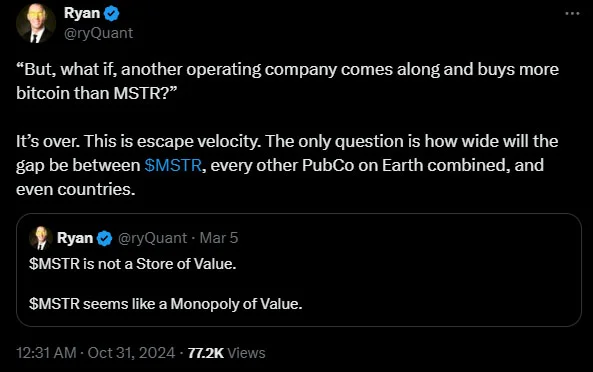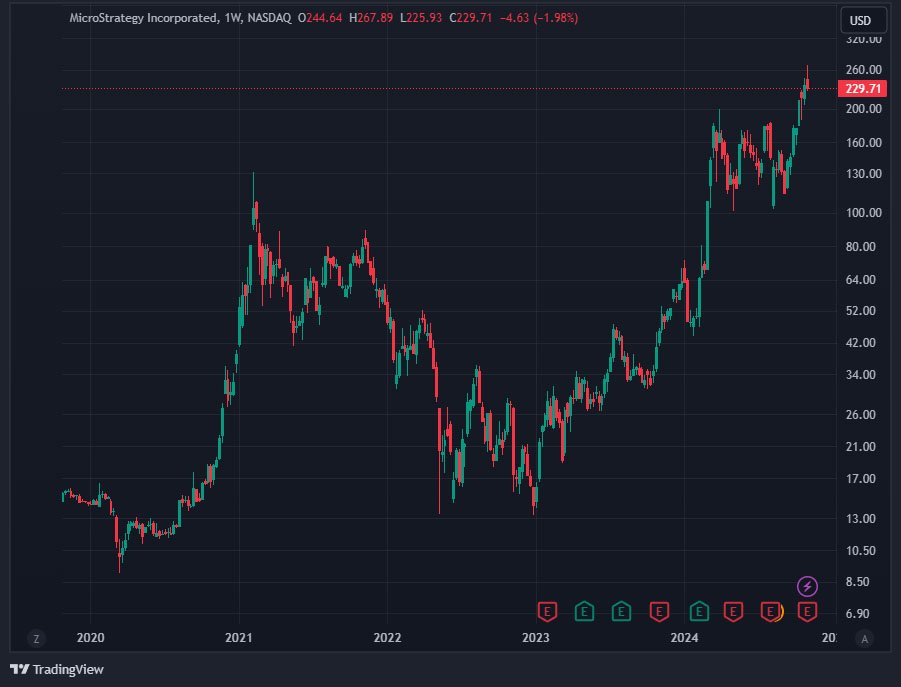In a groundbreaking move that’s turning heads across the financial world, MicroStrategy, a software company led by Bitcoin evangelist Michael Saylor, has unveiled a massive plan to invest in bitcoin like never before.
The company, known for its bullish stance on bitcoin, is planning to raise an eye-popping $42 billion over the next three years, which it intends to use solely to buy more bitcoin.

MicroStrategy’s relentless Bitcoin strategy, already unique in the business world, is apparently taking on a new life with what they’ve dubbed the “21/21 Plan.”
Announced in late October, this initiative outlines how the company will divide its capital-raising goal evenly, aiming to bring in $21 billion from equity sales and another $21 billion from debt offerings between 2025 and 2027.
The goal: to become an even bigger player in the bitcoin market while giving investors a unique avenue to gain exposure to the digital asset.
MicroStrategy first started investing in bitcoin in 2020, a move that was initially surprising for a company traditionally focused on business intelligence software.
However, with the digital asset’s massive price appreciation, MicroStrategy’s bet has so far paid off handsomely. As of September 2024, the company owns a staggering stash of 252,220 bitcoin, currently valued at around $16 billion.
MicroStrategy’s average cost per bitcoin is $39,266, meaning the company’s holdings have appreciated significantly since its initial purchase.
In a Bernstein event recently, Michael Saylor talked about his company’s plans:
“We are basically creating leverage by tapping into the convertible bond market, over time, we’ll explore the fixed income market; we’ll look at issuing preferred shares – things that are, in essence, a swap.”
In the meantime, MicroStrategy’s Q3 earnings report revealed that the company’s traditional software business has been struggling, with quarterly revenue down 10% year-over-year, marking four consecutive quarters of declines. This may be one reason why the company is doubling down on bitcoin.
Related: MicroStrategy is Now A “Bitcoin Development Company” | Saylor
Phong Le, MicroStrategy’s President and CEO, explained the logic behind the 21/21 Plan in a recent press release. He stated:
“Our focus remains to increase value generated for our shareholders by leveraging the digital transformation of capital. Today, we are announcing a strategic goal of raising $42 billion of capital over the next 3 years, comprised of $21 billion of equity and $21 billion of fixed income securities.”
Essentially, MicroStrategy sees bitcoin as a long-term store of value and a way to enhance shareholder returns through capital appreciation.
Quantitative researcher Ryan McGinnis described the strategy as achieving “escape velocity,” highlighting the widening gap between MicroStrategy and other publicly traded companies.

Andrew Kang, Senior Executive Vice President and Chief Financial Officer of MicroStrategy, highlighted the company’s careful strategy for controlling expenses and streamlining its organizational framework.
He stated, “This strategic planning across all departments in the company is focused on rightsizing overall staffing levels, optimizing organizational structures, and focusing on a disciplined performance management culture.”
MicroStrategy’s 21/21 Plan is ambitious, to say the least. For context, the company’s market value is currently around $45 billion, meaning it plans to raise nearly its entire market cap over the next three years.
MicroStrategy intends to do this by selling $21 billion in new shares and issuing another $21 billion in bonds. The bond portion is expected to include innovative financial products, such as convertible bonds and preferred shares.
Breaking down the timeline, the company plans to raise $10 billion in 2025, split between $5 billion in stock and $5 billion in bonds. In 2026, they’ll aim for $14 billion, and finally, $18 billion in 2027.
“As a Bitcoin Treasury Company, we plan to use the additional capital to buy more bitcoin as a treasury reserve asset in a manner that will allow us to achieve higher BTC yield,” Phong added.
One key metric driving this strategy is what MicroStrategy calls “BTC Yield” — the growth rate of its bitcoin holdings relative to the number of shares issued.
By aiming for a BTC Yield of between 6% and 10% annually, MicroStrategy is trying to ensure that its bitcoin holdings grow faster than the dilution effect of issuing new shares.
In 2024, the company reported a BTC Yield of 17.8%, meaning its bitcoin holdings per share had increased at a significant pace.
The BTC Yield metric is designed to reassure investors that their share in the company’s bitcoin holdings will grow rather than shrink, even as MicroStrategy issues new shares.
According to its Q3 earnings report, MicroStrategy raised $2.1 billion in Q3 alone, using $1.1 billion from stock sales and another $1 billion from bonds.
The funds were used both to purchase more bitcoin and to pay down older, more expensive debt, including a $500 million loan secured against its bitcoin holdings.
While MicroStrategy’s Bitcoin strategy has led to impressive gains, it is not without risks.
Bitcoin remains a highly volatile asset, and the company’s heavy reliance on it could backfire if the price of bitcoin takes a significant dive. Nonetheless, bitcoin’s price recently hit $70,000, close to its all-time high of nearly $74,000, which suggests continued confidence among investors.
MicroStrategy’s bitcoin holdings currently have no debt obligations attached, as the company paid off all loans backed by bitcoin in Q3 2024. This decision frees up all 252,220 bitcoin from any financial encumbrances, giving the company flexibility and a safety net in case of market downturns.
Despite the volatility, MicroStrategy’s stock has surged since it began accumulating bitcoin, with a remarkable 2,300% return for shareholders who invested when the company first entered the bitcoin market in 2020.

As traditional finance and Bitcoin worlds collide, MicroStrategy’s approach has attracted significant attention.
The company’s decision to pursue a bitcoin-centric model sets it apart from competitors and aligns with Saylor’s vision of a “digital transformation of capital.” However, critics question whether it’s wise for MicroStrategy to tie up nearly all of its resources in such a volatile asset.
For now, MicroStrategy is riding high, but its future rests on the fate of Bitcoin. If the digital asset continues its upward trend, the company could see even greater gains. But if bitcoin’s value falters, MicroStrategy could face significant losses.
Whether MicroStrategy’s Bitcoin-focused approach proves to be visionary or reckless will be determined in the years to come. But one thing is clear: the company is committed to staking its future on Bitcoin, and it’s bringing investors along for the ride.










